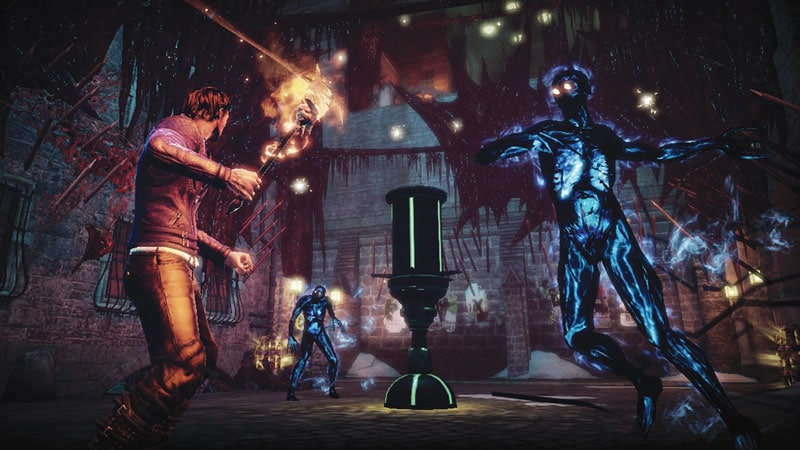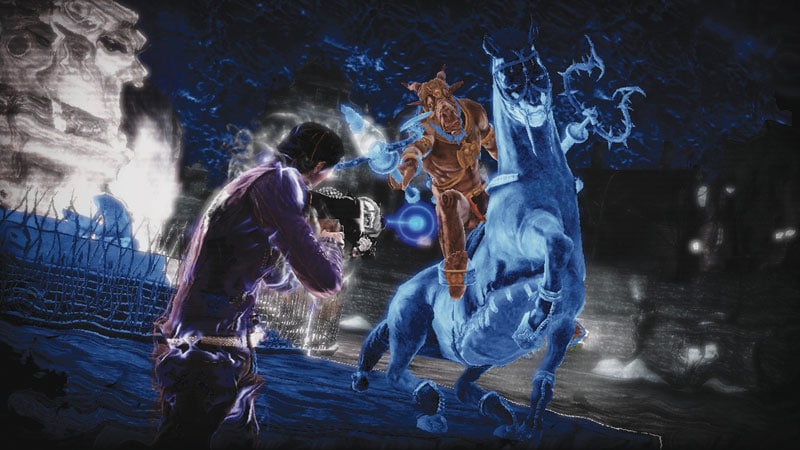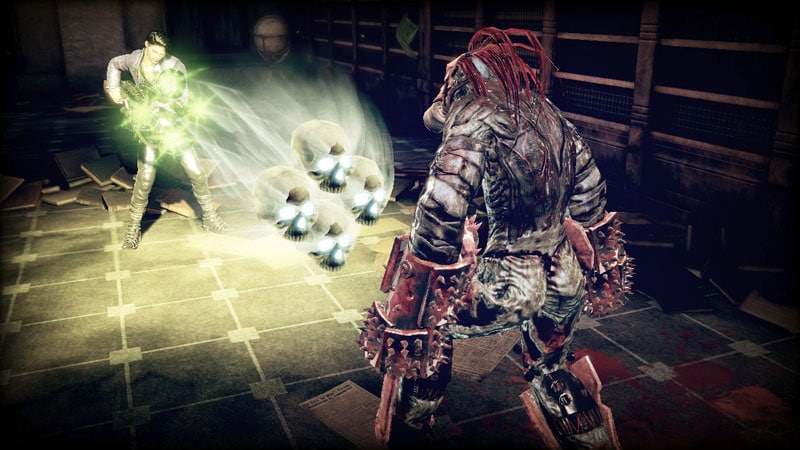Whoever categorised Shadows of the Damned as a survival horror game must have been thinking solely from the perspective of the multitudes of demons you hunt through the game, because clearly, neither survival nor fear is on the checklist of a man who leaps into hell voluntarily. Thus begins the story of Garcia Hotspur and his demon friend Johnson, or as Garcia puts it, the beginning of their very own road movie. The game kicks off with the murder and abduction (yes, in that order) of Paula, Garcia’s girlfriend, by Fleming, the lord of hell, with Garcia and Johnson in hot pursuit. Unlike Murray from the Monkey Island series, Johnson is good for more than just laughs, making himself pretty damned useful through the eight-hour adventure as a tour guide of hell, motorcycle, torch, pistol (or Boner as they call it) and a whole assortment of weapons that he can turn into.

Shadows of the Damned comes from the deviant mind of Suda51, the creator of No More Heroes, with partner-in-crime Shinji Mikami (creator of the Resident Evil series) and sound design by Akira Yamaoka of Silent Hill fame. With such a star-studded line up, Shadows of the Damned was expected to be something really special. And it is, even if there is no way to put a finger on what makes it so. The genius of Suda51 comes through in his depiction of hell, which is the game’s most unique offering. Straying away from standard fare, Goichi’s hell is more akin to an abandoned European village sporting all sorts of delinquencies. Goat heads that must be lit to keep the darkness at bay and freaky baby heads that function as locks of doors, which need to fed anything from brains to strawberries in order to unlock, are a common sight. Hell, there’s even a fully functional library.
Even if the gameplay mechanics are an assortment of the tried and tested, the aberrant and depraved world around you will keep you hooked and always interested. To add to that, the fact that the game will surprise you when you least expect it all the way to its surreal conclusion makes it one of the most outstanding games that have released this year. It’s definitely not for everyone though, especially when you consider the writing. It’s easy to dismiss it as juvenile, even poor for that matter. It is exceedingly profane and vulgar (though never unnecessary), and there are an abnormal number of jokes centered around the male genitalia. But the writing must be regarded in the context of the setting, which is when you realise just how clever it is. If Shadows of the Damned comes across as immature, it is because it intends to be so. And that makes all the difference.

What is the difference you ask? It is the difference between being dragged to hell kicking and screaming and entering hell of one’s own volition with a gun and a grin pointing forward. Through its writing, which is expertly delivered by the voice actors for both Garcia and Johnson, the game shows off some legitimate chemistry between the two, be it through dick jokes, hilarious idiosyncrasies such as movie posters that populate hell, or the tragic back stories of boss characters that are found in books. The art of the game brings out the requisite dark, oppressive and depressing look, though the graphics often lag behind. Poor texture work, and texture pop-in (even in the menus) is rampant, and the use of a dull colour palette doesn’t do the game any favours. The sound design, on the other hand, is absolutely sublime, bringing the world to life with chilling sound effects and a moody and soulful soundtrack.
All these things aside, the game must stand firm through its gameplay. Thankfully, it performs admirably in the that department as well, though it takes a more conservative approach here. The shooting is standard over-the-shoulder affair, and Mikami’s influences are very prominent here, even though it never feels as tight and polished as the Resident Evil series. Despite that, the gunplay is very satisfying, and through constant upgrades throughout the campaign, the game keeps throwing in new (or modified) toys to play with. The game encourages recklessness with ammunition, and this coupled with an upgrade like auto-targeting later in the game, tends to tip the balance in the player’s favour quite significantly. It seems like a conscious decision to keep the game accessible. As a result, Shadows of the Damned never really stretches the player, but is always fun.

That said, the game does introduce some tension into the proceedings with its darkness technique. On many occasions, Garcia will get engulfed by the darkness, which he can only withstand for so long before he starts bleeding health. He must then shut it down by taking out its sources or shooting a flare at an aforementioned goat head to restore light. The game extends this mechanic to create multiple survival challenges and puzzles (for example, certain switches can only be shot in the darkness). Boss fights mostly utilise an alternating pattern of light and darkness, with the player required to target specific body parts in different conditions. Like everything else, it never gets overwhelming, but shuffles things around just enough to keep you guessing what awaits around the next bend.
Conclusion
What is it about then? Is it a story about love so powerful that you’ll go to hell and back for it? Is it about companionship – two friends laughing and joking in the face of the most unimaginable horrors? Is it a parody of it all? Or is it a parody of a parody? Like everything else about it, Shadows of the Damned likes to keep you guessing. Maybe that’s what makes it so special.




